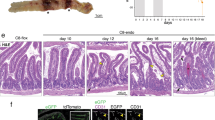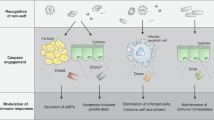Abstract
Caspase-8, a cysteine-protease, initiates apoptosis when activated by death receptors. Caspase-8 is also essential for initiating T lymphocyte proliferation following T-cell antigen receptor (TCR) signaling. Given these disparate functions of caspase-8, we sought to determine whether this represented only a difference in the magnitude of caspase-8 activation, or different intracellular locations of active caspase-8. We demonstrate by high-resolution multicolor confocal laser scanning microscopy an aggregation of active caspase-8 within membrane lipid rafts in T cells stimulated with anti-CD3. This suggests that following TCR stimulation active caspase-8 physically interacts with lipid raft proteins, possibly to form a signaling platform. In contrast, Fas stimulation of T cells resulted in a much more profound activation of caspase-8 that was exclusively cytosolic. These confocal microscopic findings were confirmed using discontinuous sucrose gradient ultracentrifugation to isolate lipid raft versus cytosolic components. This sequestration model of caspase-8 activation was further supported by the observation that a classic caspase-8 substrate, BID, was not cleaved in CD3-stimulated T cells, but was cleaved after Fas engagement. Our data support a model that the location of active caspase-8 may profoundly influence its functional capacity as a regulator of either cell cycling or cell death.
Similar content being viewed by others
Log in or create a free account to read this content
Gain free access to this article, as well as selected content from this journal and more on nature.com
or
Abbreviations
- CLSM:
-
confocal laser scanning microscopy
- FAM:
-
6-carboxyfluorescein
- FITC:
-
fluorescein isothiocyanate
- fmk:
-
fluoromethylketone
- IETD:
-
isoleucine-glutamic acid-threonine-aspartic acid
- LETD:
-
leucine-glutamic acid-threonine-aspartic acid
- TCR:
-
T-cell antigen receptor
- TUNEL:
-
terminal-dUTP-nick-end-labeling
- zVAD:
-
benzyloxycarbonyl-valine-alanine-aspartic acid
References
Cohen GM . Caspases: the executioners of apoptosis. Biochem J 1997; 326 (Part 1): 1–16.
Kumar S . Caspase function in programmed cell death. Cell Death Differ 2007; 14: 32–43.
Martinon F, Tschopp J . Inflammatory caspases and inflammasomes: master switches of inflammation. Cell Death Differ 2007; 14: 10–22.
Lamkanfi M, Festjens N, Declercq W, Vanden Berghe T, Vandenabeele P . Caspases in cell survival, proliferation and differentiation. Cell Death Differ 2007; 14: 44–55.
Donepudi M, Grutter MG . Structure and zymogen activation of caspases. Biophys Chem 2002; 101–102: 145–153.
Ho PK, Hawkins CJ . Mammalian initiator apoptotic caspases. The FEBS Journal 2005; 272: 5436–5453.
Degterev A, Boyce M, Yuan J . A decade of caspases. Oncogene 2003; 22: 8543–8567.
Salvesen GS . Caspase 8: igniting the death machine. Structure 1999; 7: R225–R229.
Peter ME, Krammer PH . The CD95(APO-1/Fas) DISC and beyond. Cell Death Differ 2003; 10: 26–35.
Salvesen GS, Dixit VM . Caspase activation: the induced-proximity model. Proc Natl Acad Sci USA 1999; 96: 10964–10967.
Chun HJ, Zheng L, Ahmad M, Wang J, Speirs CK, Siegel RM et al. Pleiotropic defects in lymphocyte activation caused by caspase-8 mutations lead to human immunodeficiency. Nature 2002; 419: 395–399.
Salmena L, Lemmers B, Hakem A, Matysiak-Zablocki E, Murakami K, Au PY et al. Essential role for caspase 8 in T-cell homeostasis and T-cell-mediated immunity. Genes Dev 2003; 17: 883–895.
Simons K, Ikonen E . Functional rafts in cell membranes. Nature 1997; 387: 569–572.
Simons K, Toomre D . Lipid rafts and signal transduction. Nat Rev Mol Cell Biol 2000; 1: 31–39.
He HT, Lellouch A, Marguet D . Lipid rafts and the initiation of T cell receptor signaling. Semin Immunol 2005; 17: 23–33.
Russell S, Oliaro J . Compartmentalization in T-cell signalling: membrane microdomains and polarity orchestrate signalling and morphology. Immunol Cell Biol 2006; 84: 107–113.
Misra RS, Russell JQ, Koenig A, Hinshaw-Makepeace JA, Wen R, Wang D et al. Caspase-8 and c-FLIPL associate in lipid rafts with NF-kappa B adaptors during T cell activation. J Biol Chem 2007; 282: 19365–19374.
Edidin M . The state of lipid rafts: from model membranes to cells. Annu Rev Biophys Biomol Struct 2003; 32: 257–283.
Lagerholm BC, Weinreb GE, Jacobson K, Thompson NL . Detecting microdomains in intact cell membranes. Annu Rev Phys Chem 2005; 56: 309–336.
Rodgers W . Making membranes green: construction and characterization of GFP-fusion proteins targeted to discrete plasma membrane domains. Biotechniques 2002; 32: 1044–1046, 1048, 1050–1041.
Kennedy NJ, Kataoka T, Tschopp J, Budd RC . Caspase activation is required for T cell proliferation. J Exp Med 1999; 190: 1891–1896.
Misra RS, Jelley-Gibbs DM, Russell JQ, Huston G, Swain SL, Budd RC . Effector CD4+ T cells generate intermediate caspase activity and cleavage of caspase-8 substrates. J Immunol 2005; 174: 3999–4009.
Juo P, Kuo CJ, Reynolds SE, Konz RF, Raingeaud J, Davis RJ et al. Fas activation of the p38 mitogen-activated protein kinase signalling pathway requires ICE/CED-3 family proteases. Mol Cell Biol 1997; 17: 24–35.
Juo P, Kuo CJ, Yuan J, Blenis J . Essential requirement for caspase-8/FLICE in the initiation of the Fas-induced apoptotic cascade. Curr Biol 1998; 8: 1001–1008.
Earnshaw WC, Martins LM, Kaufmann SH . Mammalian caspases: structure, activation, substrates, and functions during apoptosis. Annu Rev Biochem 1999; 68: 383–424.
Slee EA, Zhu H, Chow SC, MacFarlane M, Nicholson DW, Cohen GM . Benzyloxycarbonyl-Val-Ala-Asp (OMe) fluoromethylketone (Z-VAD.FMK) inhibits apoptosis by blocking the processing of CPP32. Biochem J 1996; 315 (Part 1): 21–24.
Janes PW, Ley SC, Magee AI . Aggregation of lipid rafts accompanies signaling via the T cell antigen receptor. J Cell Biol 1999; 147: 447–461.
Duplay P, Thome M, Herve F, Acuto O . p56lck interacts via its src homology 2 domain with the ZAP-70 kinase. J Exp Med 1994; 179: 1163–1172.
Manders M, Verbeek PJ, Aten JA . Measurement of co-localization of objects in dual colour confocal images. J Microsc 1993; 169: 375–382.
Micheau O, Thome M, Schneider P, Holler N, Tschopp J, Nicholson DW et al. The long form of FLIP is an activator of caspase-8 at the Fas death-inducing signaling complex. J Biol Chem 2002; 277: 45162–45171.
Edidin M . Lipids on the frontier: a century of cell-membrane bilayers. Nat Rev Mol Cell Biol 2003; 4: 414–418.
Harder T . Lipid raft domains and protein networks in T-cell receptor signal transduction. Curr Opin Immunol 2004; 16: 353–359.
Glebov OO, Nichols BJ . Lipid raft proteins have a random distribution during localized activation of the T-cell receptor. Nat Cell Biol 2004; 6: 238–243.
Magee T, Pirinen N, Adler J, Pagakis SN, Parmryd I . Lipid rafts: cell surface platforms for T cell signaling. Biol Res 2002; 35: 127–131.
Zacharias DA, Violin JD, Newton AC, Tsien RY . Partitioning of lipid-modified monomeric GFPs into membrane microdomains of live cells. Science 2002; 296: 913–916.
Kabouridis PS . Lipid rafts in T cell receptor signalling. Mol Membr Biol 2006; 23: 49–57.
Chichili GR, Rodgers W . Clustering of membrane raft proteins by the actin cytoskeleton. J Biol Chem 2007; 282: 36682–36691.
Manes S, Viola A . Lipid rafts in lymphocyte activation and migration. Mol Membr Biol 2006; 23: 59–69.
Lemmers B, Salmena L, Bidere N, Su H, Matysiak-Zablocki E, Murakami K et al. Essential role for caspase-8 in Toll-like receptors and NF-kappaB signaling. J Biol Chem 2007; 282: 7416–7423.
Su H, Bidere N, Zheng L, Cubre A, Sakai K, Dale J et al. Requirement for caspase-8 in NF-kappaB activation by antigen receptor. Science 2005; 307: 1465–1468.
Egawa T, Albrecht B, Favier B, Sunshine MJ, Mirchandani K, O’Brien W et al. Requirement for CARMA1 in antigen receptor-induced NF-kappa B activation and lymphocyte proliferation. Curr Biol 2003; 13: 1252–1258.
Gaide O, Favier B, Legler DF, Bonnet D, Brissoni B, Valitutti S et al. CARMA1 is a critical lipid raft-associated regulator of TCR-induced NF-kappa B activation. Nat Immunol 2002; 3: 836–843.
Lanzavecchia A, Scheidegger D . The use of hybrid hybridomas to target human cytotoxic T lymphocytes. Eur J Immunol 1987; 17: 105–111.
Muppidi JR, Siegel RM . Ligand-independent redistribution of Fas (CD95) into lipid rafts mediates clonotypic T cell death. Nat Immunol 2004; 5: 182–189.
Acknowledgements
This work was supported by grants from the National Institutes of Health (AI36333, AI45666 and AR43520 to RCB, and R01GM070001 to WAR). We thank Dr. Douglas Taatjes and Marilyn Wadsworth for help and discussions concerning confocal laser scanning microscopy, and Colette Charland and Julie Wolfe for technical assistance with flow cytometry, and Tim Hunter and Scott Tighe for technical assistance with densitometry.
Author information
Authors and Affiliations
Corresponding author
Additional information
Edited by DR Green
Supplementary Information accompanies the paper on Cell Death and Differentiation website (http://www.nature.com/cdd)
Rights and permissions
About this article
Cite this article
Koenig, A., Russell, J., Rodgers, W. et al. Spatial differences in active caspase-8 defines its role in T-cell activation versus cell death. Cell Death Differ 15, 1701–1711 (2008). https://doi.org/10.1038/cdd.2008.100
Received:
Revised:
Accepted:
Published:
Issue date:
DOI: https://doi.org/10.1038/cdd.2008.100
Keywords
This article is cited by
-
Glycolysis promotes caspase-3 activation in lipid rafts in T cells
Cell Death & Disease (2018)
-
IL-15 maintains T-cell survival via S-nitrosylation-mediated inhibition of caspase-3
Cell Death & Differentiation (2014)
-
Caspase-8 cleaves its substrates from the plasma membrane upon CD95-induced apoptosis
Cell Death & Differentiation (2013)
-
Caspase blockade induces RIP3-mediated programmed necrosis in Toll-like receptor-activated microglia
Cell Death & Disease (2013)
-
Regulation of NF-κB signaling by caspases and MALT1 paracaspase
Cell Research (2011)



